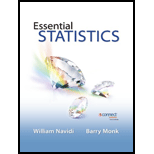
Find the 95% confidence interval for the group means or group proportions for the health characteristics.
Answer to Problem 3CS
The 95% confidence intervals for the each of the characteristics are as follows:
| Characteristic | 95% confidence interval |
| Age | |
| Systolic blood pressure | |
| Diastolic blood pressure | |
| Treatment for hypertension | |
| Atrial fibrillation | |
| Diabetes | |
| Cigarette smoking | |
| Coronary bypass surgery |
Explanation of Solution
Calculation:
The data represents the means and standard deviations corresponding to three characteristics of standard treatment and new treatment.
Furthermore, the data corresponding to the percentage with the characteristics for the 5 characteristics for standard treatment and new treatment is given.
Here, it is given that the
95% confidence interval for the variable “Age”:
Software Procedure:
Step by step procedure to find 95% confidence interval forthe difference between the two population means using the MINITAB software:
- Choose Stat > Basic Statistics > 2-Sample t.
- Choose Summarized data.
- In first sample, enter the sample size as 731, sample mean as 64 and sample standard deviation as 11.
- In second sample, enter the sample size as 1,089, sample mean as 65 and sample standard deviation as 11.
- Choose Options.
- In Confidence level, enter 95.
- Enter 0 in Hypothesized value.
- In Alternative, select not equal to
- Click OK in all the dialogue boxes.
Output using the MINITAB software is given below:
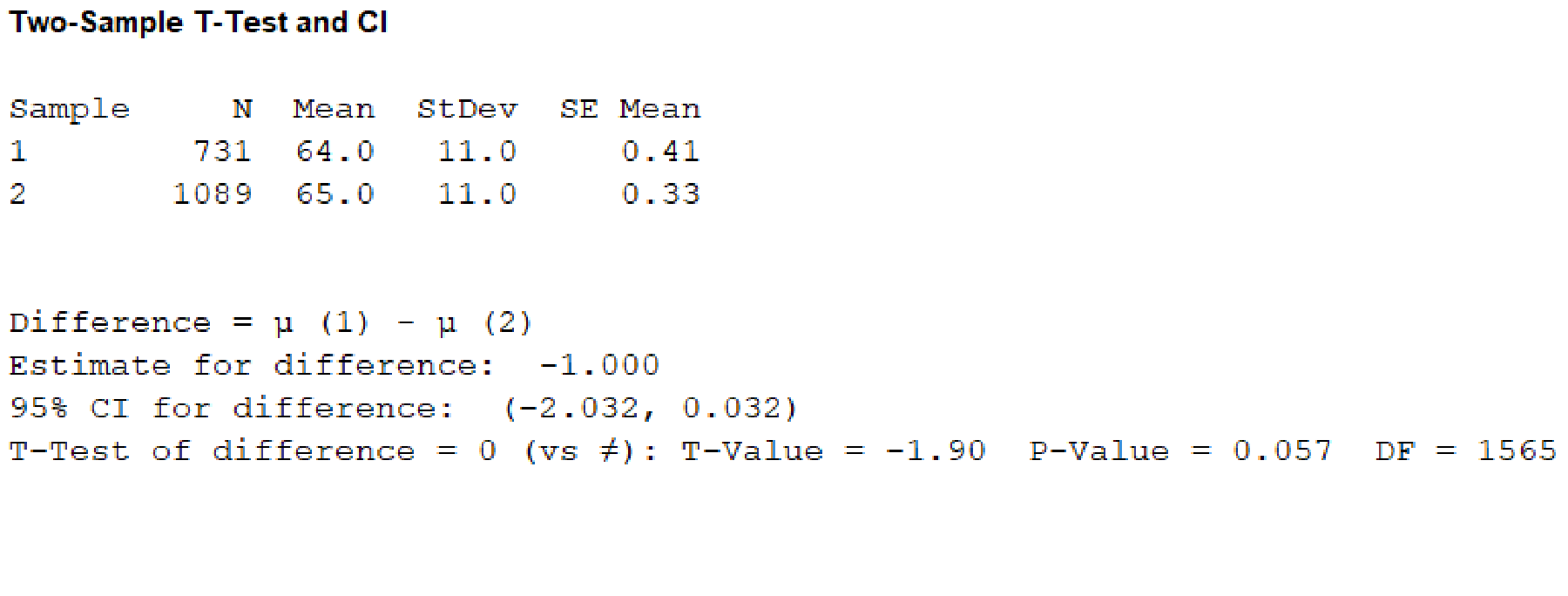
From, the MINITAB output the 95% confidence interval for the difference between the mean age of new treatment and standard treatment is
95% confidence interval for the variable “Systolic blood pressure”:
Software Procedure:
Step by step procedure to find 95% confidence interval forthe difference between the two population means using the MINITAB software:
- Choose Stat > Basic Statistics > 2-Sample t.
- Choose Summarized data.
- In first sample, enter the sample size as 731, sample mean as 121 and sample standard deviation as 18.
- In second sample, enter the sample size as 1,089, sample mean as 124 and sample standard deviation as 17.
- Choose Options.
- In Confidence level, enter 95.
- Enter 0 in Hypothesized value.
- In Alternative, select not equal to
- Click OK in all the dialogue boxes.
Output using the MINITAB software is given below:

From, the MINITAB output the 95% confidence interval for the difference between the mean systolic blood pressure of new treatment and standard treatmentis
95% confidence interval for the variable “Diastolic blood pressure”:
Software Procedure:
Step by step procedure to find 95% confidence interval for the difference between the two population means using the MINITAB software:
- Choose Stat > Basic Statistics > 2-Sample t.
- Choose Summarized data.
- In first sample, enter the sample size as 731, sample mean as 71 and sample standard deviation as 10.
- In second sample, enter the sample size as 1,089, sample mean as 72 and sample standard deviation as 10.
- Choose Options.
- In Confidence level, enter 95.
- Enter 0 in Hypothesized value.
- In Alternative, select not equal to
- Click OK in all the dialogue boxes.
Output using the MINITAB software is given below:
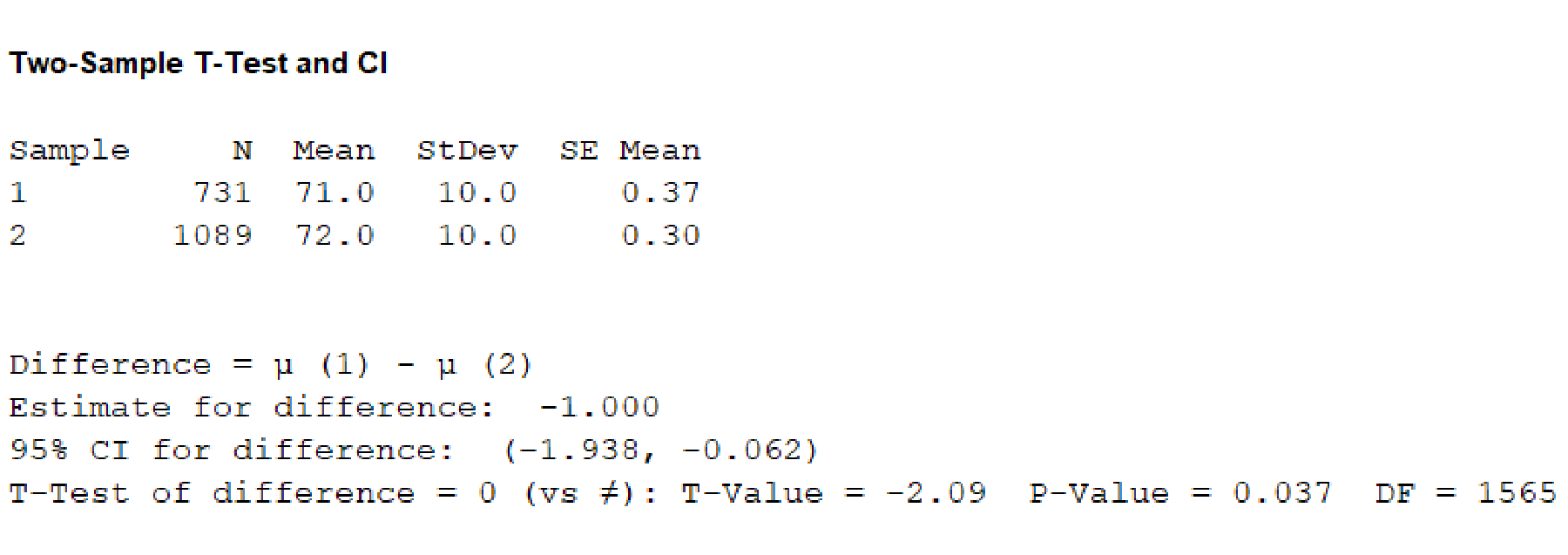
From, the MINITAB output the 95% confidence interval for the difference between the mean diastolic blood pressure of new treatment and standard treatmentis
95% confidence interval for the variable “Treatment for hypertension”:
The sample size of standard treatment is
Hence, the specified characteristics of treatment for hypertension under new treatment is
The sample size of new treatment is
Hence, the specified characteristics of treatment for hypertension under new treatment is
Software Procedure:
Step by step procedure to find 95% confidence interval for the difference between the two population proportions using the MINITAB software:
- Choose Stat > Basic Statistics > 2-Proportions.
- Choose Summarized data.
- In first sample, enter the number of trials as 731 and number of events as 462.
- In second sample, enter the number of trials as 1,089 and number of events as 694.
- Choose Options.
- In Confidence level, enter 95.
- Enter 0 in Hypothesized value.
- In Alternative, select not equal to
- Click OK in all the dialogue boxes.
Output using the MINITAB software is given below:
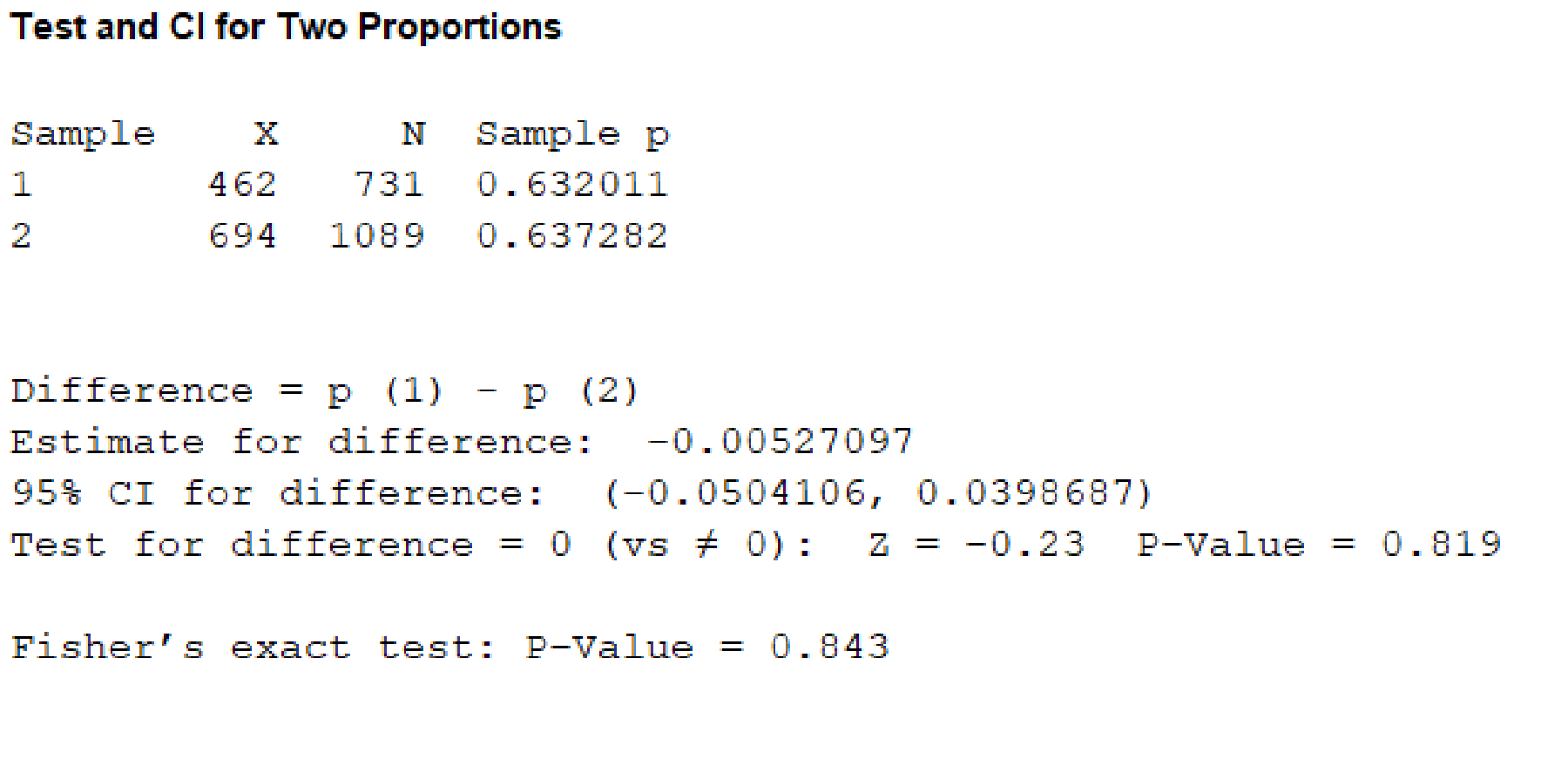
From, the MINITAB output the 95% confidence interval for the difference between the proportion of treatment for hypertension under new treatment and standard treatmentis
95% confidence interval for the variable “Atrial fibrillation”:
The sample size of standard treatment is
Hence, the specified characteristics of treatment for Atrial fibrillation under standard treatment is
The sample size of new treatment is
Hence, the specified characteristics of Atrial fibrillation under new treatment is
Software Procedure:
Step by step procedure to find 95% confidence interval for the difference between the two populationproportions using the MINITAB software:
- Choose Stat > Basic Statistics > 2-Proportions.
- Choose Summarized data.
- In first sample, enter the number of trials as 731 and number of events as 92.
- In second sample, enter the number of trials as 1,089 and number of events as 121.
- Choose Options.
- In Confidence level, enter 95.
- Enter 0 in Hypothesized value.
- In Alternative, select not equal to
- Click OK in all the dialogue boxes.
Output using the MINITAB software is given below:
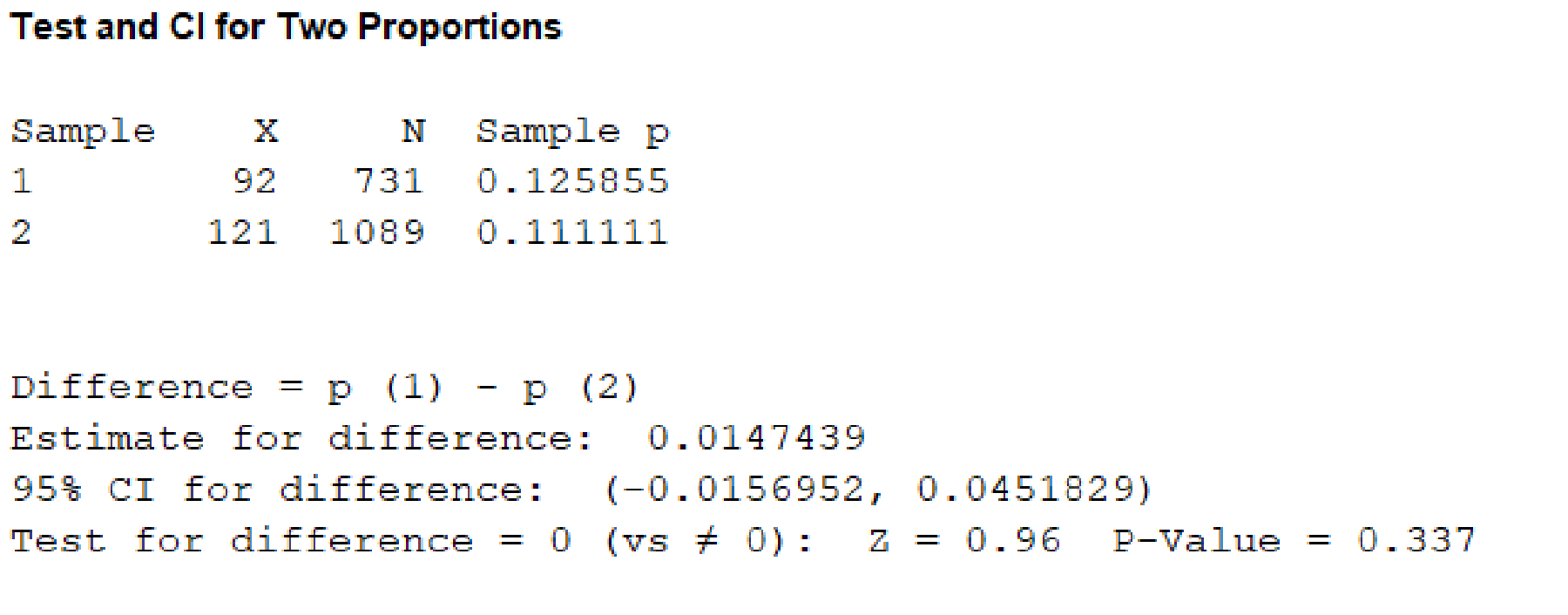
From, the MINITAB output the 95% confidence interval for the difference between the proportion of Atrial fibrillation under new treatment and standard treatment is
95% confidence interval for the variable “Diabetes”:
The sample size of standard treatment is
Hence, the specified characteristics of diabetes under standard treatment is
The sample size of new treatment is
Hence, the specified characteristics of diabetes under new treatment is
Software Procedure:
Step by step procedure to find 95% confidence interval for the difference between the two population proportions using the MINITAB software:
- Choose Stat > Basic Statistics > 2-Proportions.
- Choose Summarized data.
- In first sample, enter the number of trials as 731 and number of events as 221.
- In second sample, enter the number of trials as 1,089 and number of events as 333.
- Choose Options.
- In Confidence level, enter 95.
- Enter 0 in Hypothesized value.
- In Alternative, select not equal to
- Click OK in all the dialogue boxes.
Output using the MINITAB software is given below:
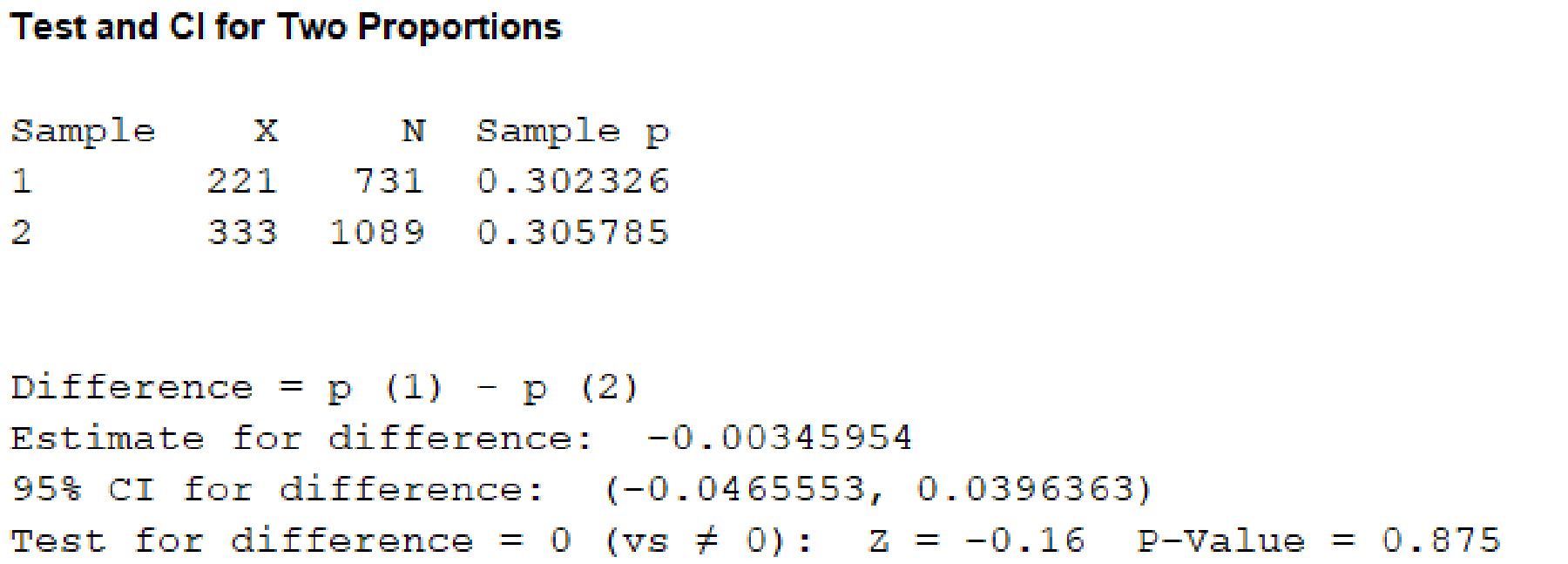
From, the MINITAB output the95% confidence interval for the difference between the proportion of Diabetes under new treatment and standard treatment is
95% confidence interval for the variable “Cigarette smoking”:
The sample size of standard treatment is
Hence, the specified characteristics of cigarette smoking under standard treatment is
The sample size of new treatment is
Hence, the specified characteristics of cigarette smoking under new treatment is
Software Procedure:
Step by step procedure to find 95% confidence interval for the difference between the two population proportions using the MINITAB software:
- Choose Stat > Basic Statistics > 2-Proportions.
- Choose Summarized data.
- In first sample, enter the number of trials as 731 and number of events as 94.
- In second sample, enter the number of trials as 1,089 and number of events as 124.
- Choose Options.
- In Confidence level, enter 95.
- Enter 0 in Hypothesized value.
- In Alternative, select not equal to
- Click OK in all the dialogue boxes.
Output using the MINITAB software is given below:
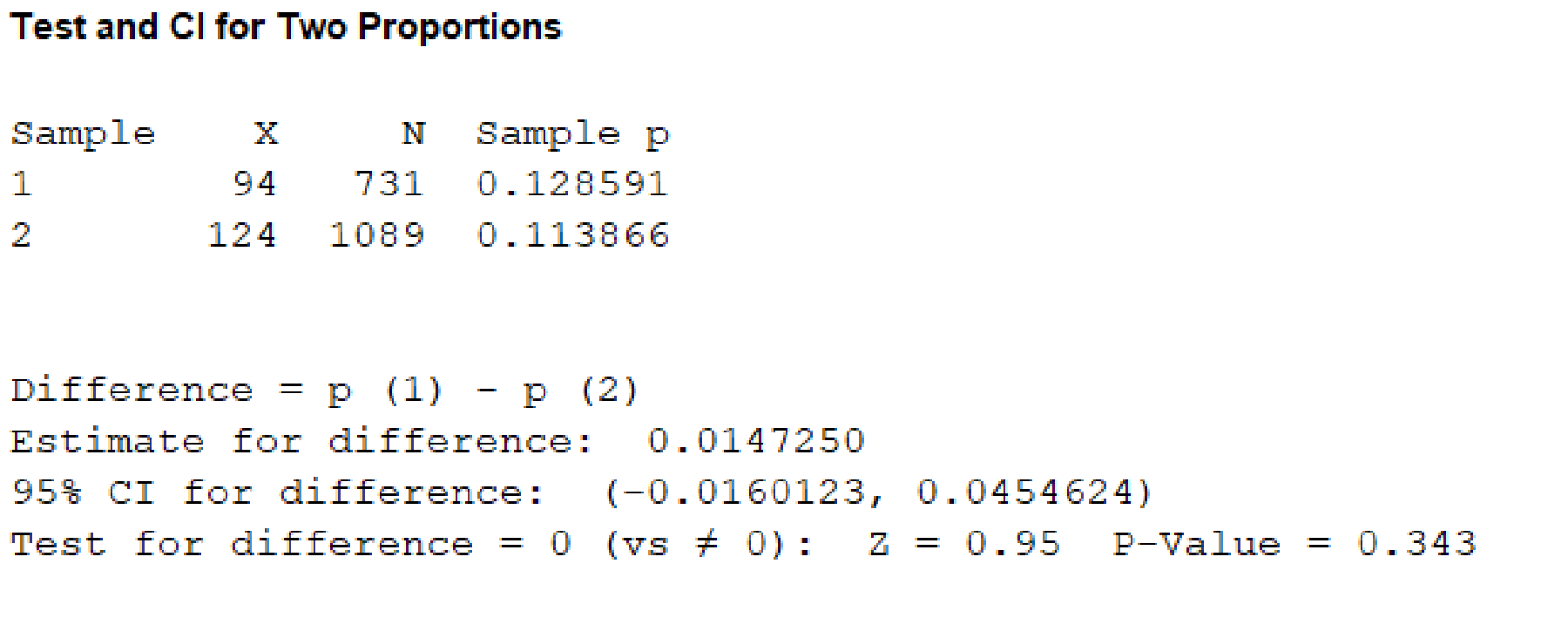
From, the MINITAB output the 95% confidence interval for the difference between the proportion of Cigarette smoking under new treatment and standard treatment is
95% confidence interval for the variable “Coronary bypass surgery”:
The sample size of standard treatment is
Hence, the specified characteristics of Coronary bypass surgery under standard treatment is
The sample size of new treatment is
Hence, the specified characteristics of coronary bypass surgery under new treatment is
Software Procedure:
Step by step procedure to find 95% confidence interval for the difference between the two population proportions using the MINITAB software:
- Choose Stat > Basic Statistics > 2-Proportions.
- Choose Summarized data.
- In first sample, enter the number of trials as 1,089 and number of events as 317.
- In second sample, enter the number of trials as 731 and number of events as 208.
- Choose Options.
- In Confidence level, enter 95.
- Enter 0 in Hypothesized value.
- In Alternative, select not equal to
- Click OK in all the dialogue boxes.
Output using the MINITAB software is given below:
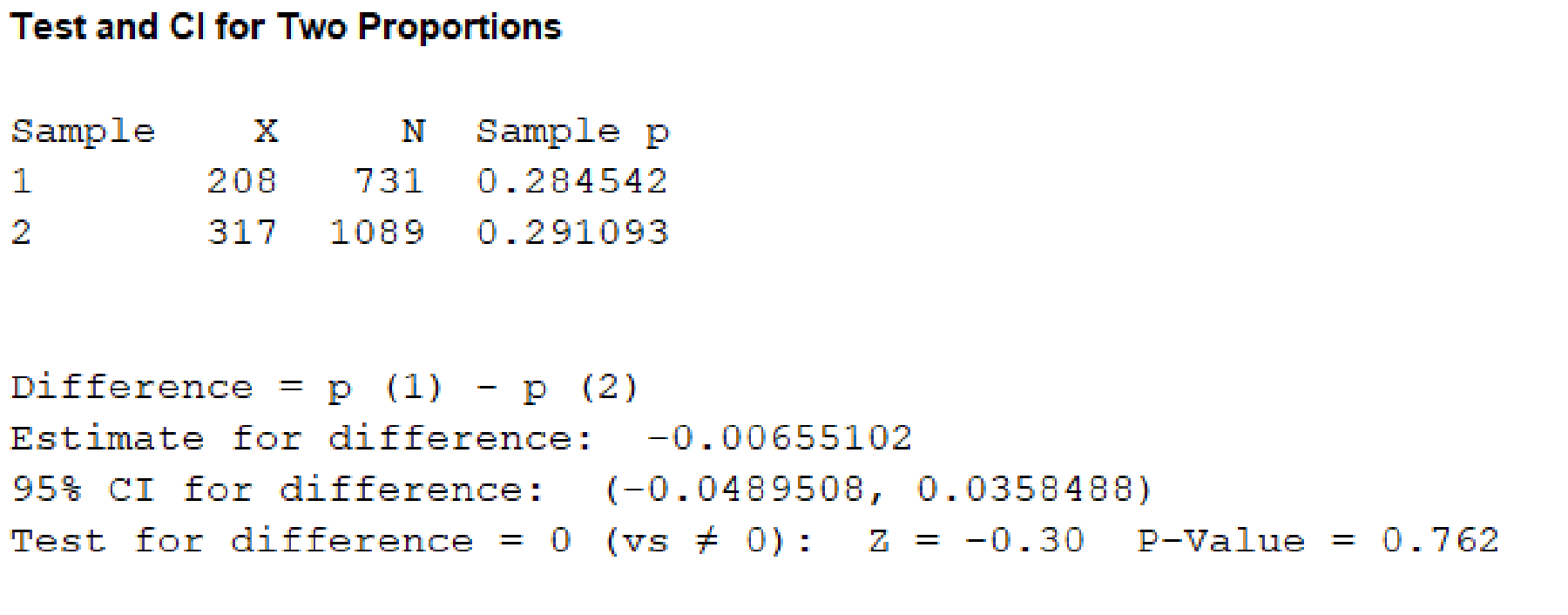
From, the MINITAB output the 95% confidence interval for the difference between the proportion of Coronary bypass surgery under new treatment and standard treatment is
Want to see more full solutions like this?
Chapter 9 Solutions
Essential Statistics
- Analyze the residuals of a linear regression model and select the best response.Criteria is simple evaluation of possible indications of an exponential model vs. linear model) no, the residual plot does not show a curve yes, the residual plot does not show a curve yes, the residual plot shows a curve no, the residual plot shows a curve I selected: yes, the residual plot shows a curve and it is INCORRECT. Can u help me understand why?arrow_forwardYou have been hired as an intern to run analyses on the data and report the results back to Sarah; the five questions that Sarah needs you to address are given below. please do it step by step on excel Does there appear to be a positive or negative relationship between price and screen size? Use a scatter plot to examine the relationship. Determine and interpret the correlation coefficient between the two variables. In your interpretation, discuss the direction of the relationship (positive, negative, or zero relationship). Also discuss the strength of the relationship. Estimate the relationship between screen size and price using a simple linear regression model and interpret the estimated coefficients. (In your interpretation, tell the dollar amount by which price will change for each unit of increase in screen size). Include the manufacturer dummy variable (Samsung=1, 0 otherwise) and estimate the relationship between screen size, price and manufacturer dummy as a multiple…arrow_forwardHere is data with as the response variable. x y54.4 19.124.9 99.334.5 9.476.6 0.359.4 4.554.4 0.139.2 56.354 15.773.8 9-156.1 319.2Make a scatter plot of this data. Which point is an outlier? Enter as an ordered pair, e.g., (x,y). (x,y)= Find the regression equation for the data set without the outlier. Enter the equation of the form mx+b rounded to three decimal places. y_wo= Find the regression equation for the data set with the outlier. Enter the equation of the form mx+b rounded to three decimal places. y_w=arrow_forward
- You have been hired as an intern to run analyses on the data and report the results back to Sarah; the five questions that Sarah needs you to address are given below. please do it step by step Does there appear to be a positive or negative relationship between price and screen size? Use a scatter plot to examine the relationship. Determine and interpret the correlation coefficient between the two variables. In your interpretation, discuss the direction of the relationship (positive, negative, or zero relationship). Also discuss the strength of the relationship. Estimate the relationship between screen size and price using a simple linear regression model and interpret the estimated coefficients. (In your interpretation, tell the dollar amount by which price will change for each unit of increase in screen size). Include the manufacturer dummy variable (Samsung=1, 0 otherwise) and estimate the relationship between screen size, price and manufacturer dummy as a multiple linear…arrow_forwardExercises: Find all the whole number solutions of the congruence equation. 1. 3x 8 mod 11 2. 2x+3= 8 mod 12 3. 3x+12= 7 mod 10 4. 4x+6= 5 mod 8 5. 5x+3= 8 mod 12arrow_forwardScenario Sales of products by color follow a peculiar, but predictable, pattern that determines how many units will sell in any given year. This pattern is shown below Product Color 1995 1996 1997 Red 28 42 21 1998 23 1999 29 2000 2001 2002 Unit Sales 2003 2004 15 8 4 2 1 2005 2006 discontinued Green 26 39 20 22 28 14 7 4 2 White 43 65 33 36 45 23 12 Brown 58 87 44 48 60 Yellow 37 56 28 31 Black 28 42 21 Orange 19 29 Purple Total 28 42 21 49 68 78 95 123 176 181 164 127 24 179 Questions A) Which color will sell the most units in 2007? B) Which color will sell the most units combined in the 2007 to 2009 period? Please show all your analysis, leave formulas in cells, and specify any assumptions you make.arrow_forward
- One hundred students were surveyed about their preference between dogs and cats. The following two-way table displays data for the sample of students who responded to the survey. Preference Male Female TOTAL Prefers dogs \[36\] \[20\] \[56\] Prefers cats \[10\] \[26\] \[36\] No preference \[2\] \[6\] \[8\] TOTAL \[48\] \[52\] \[100\] problem 1 Find the probability that a randomly selected student prefers dogs.Enter your answer as a fraction or decimal. \[P\left(\text{prefers dogs}\right)=\] Incorrect Check Hide explanation Preference Male Female TOTAL Prefers dogs \[\blueD{36}\] \[\blueD{20}\] \[\blueE{56}\] Prefers cats \[10\] \[26\] \[36\] No preference \[2\] \[6\] \[8\] TOTAL \[48\] \[52\] \[100\] There were \[\blueE{56}\] students in the sample who preferred dogs out of \[100\] total students.arrow_forwardBusiness discussarrow_forwardYou have been hired as an intern to run analyses on the data and report the results back to Sarah; the five questions that Sarah needs you to address are given below. Does there appear to be a positive or negative relationship between price and screen size? Use a scatter plot to examine the relationship. Determine and interpret the correlation coefficient between the two variables. In your interpretation, discuss the direction of the relationship (positive, negative, or zero relationship). Also discuss the strength of the relationship. Estimate the relationship between screen size and price using a simple linear regression model and interpret the estimated coefficients. (In your interpretation, tell the dollar amount by which price will change for each unit of increase in screen size). Include the manufacturer dummy variable (Samsung=1, 0 otherwise) and estimate the relationship between screen size, price and manufacturer dummy as a multiple linear regression model. Interpret the…arrow_forward
- Does there appear to be a positive or negative relationship between price and screen size? Use a scatter plot to examine the relationship. How to take snapshots: if you use a MacBook, press Command+ Shift+4 to take snapshots. If you are using Windows, use the Snipping Tool to take snapshots. Question 1: Determine and interpret the correlation coefficient between the two variables. In your interpretation, discuss the direction of the relationship (positive, negative, or zero relationship). Also discuss the strength of the relationship. Value of correlation coefficient: Direction of the relationship (positive, negative, or zero relationship): Strength of the relationship (strong/moderate/weak): Question 2: Estimate the relationship between screen size and price using a simple linear regression model and interpret the estimated coefficients. In your interpretation, tell the dollar amount by which price will change for each unit of increase in screen size. (The answer for the…arrow_forwardIn this problem, we consider a Brownian motion (W+) t≥0. We consider a stock model (St)t>0 given (under the measure P) by d.St 0.03 St dt + 0.2 St dwt, with So 2. We assume that the interest rate is r = 0.06. The purpose of this problem is to price an option on this stock (which we name cubic put). This option is European-type, with maturity 3 months (i.e. T = 0.25 years), and payoff given by F = (8-5)+ (a) Write the Stochastic Differential Equation satisfied by (St) under the risk-neutral measure Q. (You don't need to prove it, simply give the answer.) (b) Give the price of a regular European put on (St) with maturity 3 months and strike K = 2. (c) Let X = S. Find the Stochastic Differential Equation satisfied by the process (Xt) under the measure Q. (d) Find an explicit expression for X₁ = S3 under measure Q. (e) Using the results above, find the price of the cubic put option mentioned above. (f) Is the price in (e) the same as in question (b)? (Explain why.)arrow_forwardProblem 4. Margrabe formula and the Greeks (20 pts) In the homework, we determined the Margrabe formula for the price of an option allowing you to swap an x-stock for a y-stock at time T. For stocks with initial values xo, yo, common volatility σ and correlation p, the formula was given by Fo=yo (d+)-x0Þ(d_), where In (±² Ꭲ d+ õ√T and σ = σ√√√2(1 - p). дго (a) We want to determine a "Greek" for ỡ on the option: find a formula for θα (b) Is дго θα positive or negative? (c) We consider a situation in which the correlation p between the two stocks increases: what can you say about the price Fo? (d) Assume that yo< xo and p = 1. What is the price of the option?arrow_forward
 MATLAB: An Introduction with ApplicationsStatisticsISBN:9781119256830Author:Amos GilatPublisher:John Wiley & Sons Inc
MATLAB: An Introduction with ApplicationsStatisticsISBN:9781119256830Author:Amos GilatPublisher:John Wiley & Sons Inc Probability and Statistics for Engineering and th...StatisticsISBN:9781305251809Author:Jay L. DevorePublisher:Cengage Learning
Probability and Statistics for Engineering and th...StatisticsISBN:9781305251809Author:Jay L. DevorePublisher:Cengage Learning Statistics for The Behavioral Sciences (MindTap C...StatisticsISBN:9781305504912Author:Frederick J Gravetter, Larry B. WallnauPublisher:Cengage Learning
Statistics for The Behavioral Sciences (MindTap C...StatisticsISBN:9781305504912Author:Frederick J Gravetter, Larry B. WallnauPublisher:Cengage Learning Elementary Statistics: Picturing the World (7th E...StatisticsISBN:9780134683416Author:Ron Larson, Betsy FarberPublisher:PEARSON
Elementary Statistics: Picturing the World (7th E...StatisticsISBN:9780134683416Author:Ron Larson, Betsy FarberPublisher:PEARSON The Basic Practice of StatisticsStatisticsISBN:9781319042578Author:David S. Moore, William I. Notz, Michael A. FlignerPublisher:W. H. Freeman
The Basic Practice of StatisticsStatisticsISBN:9781319042578Author:David S. Moore, William I. Notz, Michael A. FlignerPublisher:W. H. Freeman Introduction to the Practice of StatisticsStatisticsISBN:9781319013387Author:David S. Moore, George P. McCabe, Bruce A. CraigPublisher:W. H. Freeman
Introduction to the Practice of StatisticsStatisticsISBN:9781319013387Author:David S. Moore, George P. McCabe, Bruce A. CraigPublisher:W. H. Freeman





